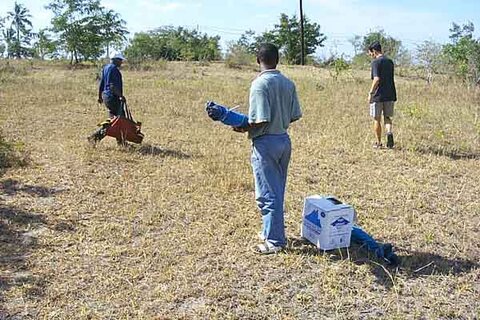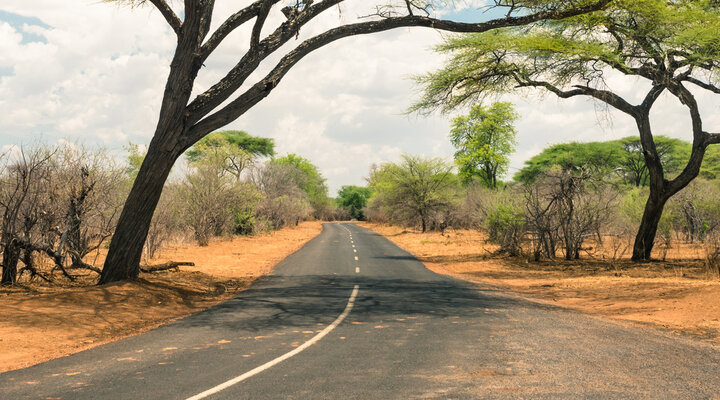How to assemble a Zimbabwe-made Epsilon trap
The Epsilon trap was developed in Zimbabwe to catch savanna species of tsetse such as G. pallidipes and G. morsitans. It is designed to be highly selective for tsetse and as a result, unlike the Nzi trap, the Epsilon is relatively inefficient for other species of fly such as stable flies, horseflies and non-biting flies.

1. First choose a suitable site.
Details of what to look for in a good site for a trap can be found in the FAQ section of this site.

2. Clear the site of vegetation that could provide a mechanical or visual barrier to the trap.

3. Clear the ground where the trap will sit and make it as flat as possible.

4. Most of the trap components are provided in a single package.

5. Check that you have the trap cover, poles, pegs and guy ropes.

6. You will also need a cage to retain the insects after capture.

7. The only other tool you need is a decent hammer.

8. There are three types of pole

9. The three long poles are inserted into the corners of the trap

10. The pole with the flat end is placed at the back.

11. Look for a small sleeve at the trap entrance

12. Insert the shortest pole into this sleeve

13. Insert the pole all the way into this sleeve

14. Pass the ropes through the loops at the corners

15. Check the wind direction - most easily with light pieces of dead vegetation.

16. Position the trap so that the entrance faces downwind

17. Hammer the pegs into the ground to take the guy ropes to each corner

18. Attach the ropes to the pegs and tighten ropes to support trap

19. Try to avoid gaps between cloth and ground like this

20. Now you need to attach the cage to retain the tsetse attracted into the trap.

21. Take the funnel and insert it through the hole in the netting

22. Fit the top of the cage onto the funnel.

23. It is crucially important to get the attachment to the netting right. It should be as neat as possible and look something like this.

24. There should be no large gaps like this

25. Or even small holes like this, big enough to allow a fly to escape.

26. And don't use large amounts of thick string which can deter tsetse from entering the cage

27. Attach a polythene bag to the cage.

28. Place an odour sachet in one of the pockets

29. et voila! The trap and site should look something like this

30. Don't forget to put traps in nice open sites

31. Don't put them near trees

32. And make sure the cover is not all floppy like this

33. When dismantling the trap, remove the small central pole and fold the trap flat

34. Place the poles, pegs and ropes on the trap

35. Roll the trap up

36. Tie it with one of the ropes

